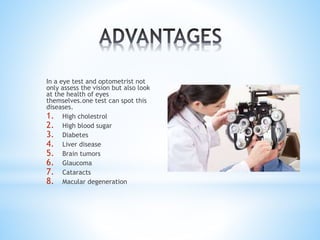Finest Refractive Surgeries in AL: State-of-the-Art Eye Care
Finest Refractive Surgeries in AL: State-of-the-Art Eye Care
Blog Article
The Function of Advanced Diagnostic Devices in Identifying Eye Disorders
In the world of ophthalmology, the usage of advanced analysis tools has changed the early identification and administration of numerous eye conditions. From identifying refined adjustments in the optic nerve to keeping track of the progression of retinal diseases, these modern technologies play an essential role in enhancing the precision and effectiveness of diagnosing ocular problems. As the demand for precise and prompt diagnoses continues to expand, the combination of sophisticated tools like optical comprehensibility tomography and visual field screening has actually become vital in the realm of eye care. The detailed interaction between technology and sensory practices not just clarifies elaborate pathologies however also opens up doors to customized treatment approaches.
Significance of Very Early Medical Diagnosis
Early medical diagnosis plays an essential duty in the effective administration and treatment of eye disorders. Prompt recognition of eye problems is crucial as it enables punctual intervention, potentially protecting against more progression of the disease and decreasing lasting problems. By discovering eye disorders at an onset, health care providers can provide proper treatment plans customized to the details problem, eventually causing far better results for clients. Early medical diagnosis allows clients to accessibility essential support solutions and sources quicker, boosting their overall top quality of life.

Innovation for Finding Glaucoma
Innovative diagnostic innovations play a crucial function in the very early detection and surveillance of glaucoma, a leading reason for irreversible blindness worldwide. One such innovation is optical comprehensibility tomography (OCT), which offers thorough cross-sectional pictures of the retina, allowing for the measurement of retinal nerve fiber layer thickness. This measurement is crucial in assessing damage caused by glaucoma. One more sophisticated device is aesthetic field testing, which maps the level of sensitivity of a person's visual field, assisting to discover any type of locations of vision loss feature of glaucoma. Additionally, tonometry is utilized to measure intraocular pressure, a significant threat variable for glaucoma. This examination is critical as raised intraocular stress can bring about optic nerve damage. Furthermore, newer modern technologies like making use of expert system formulas in assessing imaging information are showing encouraging lead to the early discovery of glaucoma. These innovative analysis tools enable eye doctors to diagnose glaucoma in its very early stages, enabling timely treatment and better administration of the disease to avoid vision loss.
Function of Optical Comprehensibility Tomography

OCT's capability to evaluate retinal nerve fiber layer thickness allows for exact and unbiased dimensions, assisting in the very early detection of glaucoma even before visual area defects end up being evident. On the whole, OCT plays a crucial role in enhancing the analysis precision and monitoring of glaucoma, inevitably contributing to much better outcomes for individuals at threat of vision loss.
Enhancing Medical Diagnosis With Visual Area Testing
A crucial element in extensive ophthalmic evaluations, aesthetic area testing plays a pivotal duty in improving the diagnostic procedure for numerous eye problems. By examining the full extent of a patient's aesthetic field, this examination supplies important information about the functional honesty of the entire aesthetic path, from the retina to the visual cortex.
Aesthetic field screening is especially beneficial in the diagnosis and administration of problems such as glaucoma, optic nerve conditions, and numerous neurological diseases that can impact vision. Through quantitative dimensions of outer and central vision, medical professionals can identify subtle modifications that might suggest the visibility or development of these disorders, even prior to recognizable symptoms occur.
Moreover, aesthetic area screening enables the monitoring of treatment efficacy, assisting eye doctors customize healing treatments to specific patients. eyecare near me. By tracking modifications in visual field performance in time, doctor can make enlightened choices about adjusting medications, advising medical interventions, or executing other appropriate actions to maintain or boost an individual's aesthetic feature
Handling Macular Degeneration

Conclusion
In conclusion, progressed diagnostic devices play an important role in recognizing eye disorders early on. Technologies such as Optical Comprehensibility Tomography and visual area screening have significantly improved the precision and effectiveness of identifying problems like glaucoma and macular deterioration.
Report this page